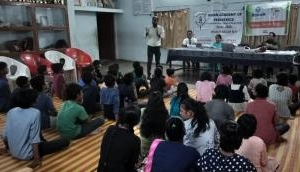Don’t ignore an itch or rash. Fungal infection is becoming an epidemic in India
_80105_730x419-m.jpg)
A small itch on the body or a rash can no longer be taken lightly because it can be a fungal infection.
According to medical experts at Chandigarh-based Post Graduate Institute of Medical Education (PGIMER), fungal infections of the skin have assumed an epidemic-like proportion in India over the last five-seven years.
Fungal infection of the skin is one of the most common infections seen at PGIMER's dermatology outpatient clinic. Doctors say such infections were considered easy to be treated. But in the last few years recurrent and chronic infections have become difficult to treat. The ailment, known as Dermatophytosis or Tinea in medical terms, has become widespread.
Professor Sunil Dogra of PGIMER's Department of Dermatology says that the problem of recurrent Dermatophytosis has become a disease of public health importance. Some 20-40% skin OPD patients across the country now suffer from recurrent ringworm infection which has been gradually growing in proportion over last four to five years.
He has an interesting take on the reason behind this growth of the problem. He says this problem is particularly faced in India due to wrong prescription pattern, misuse or self use of over the counter available ointments and creams, poor treatment compliance, overcrowding, humid environment and increasing trend of tight fitted clothes and shoes with poor ventilation. The expert points out that most of the cases are misdiagnosed or wrongly treated by quacks or patients use self medication by looking at various advertisements before presenting to skin specialists.
Professor Dogra is of the view that indiscriminate use of topical steroid combinations which are easily available from any chemist shop is seen as one of the major reasons for this acute infection assuming a chronic and difficult to manage status. “We are seeing clinical forms and severity of Tinea Corporis (scalp) or Cruris (groin) which we had never encountered in the past including Tinea Capitis (scalp and beard) in adults. It is the topic of discussion in almost all dermatology conferences in India over last few years,” he says.
In fact this was once again dealt at length during a two day conference held at the PGIMER on the weekend entitled “Dermatophytosis: Fighting the Challenge”. This conference was the first of its kind. It was organised because the Indian Association of Dermatologists Venereologists and Leprologists (IADVL) members felt that the problem needed to be addressed. The conference was preceded by a workshop for microbiologists and dermatologists on various aspects of laboratory diagnosis and anti fungal susceptibility tests in Dermatophytosis.
Dr Tarun Narang who was the organising secretary of the conference, said that the conference was attended by 250 medical experts from India and abroad and covered all aspects of the infections. While advocating a high level of personal hygiene with special emphasis on wiping off the moisture from web spaces on the body, the experts lay maximum emphasis on wearing loose fitting cotton dresses. Tight-fitting denims, leggings and synthetic clothes are something that should not be worn as they increase the chance of a person getting a fungal infection. Another catch is that the washed clothes need to be sun dried inside out. They point out that medication should be taken as per doctor's prescription with regular reviewing and nothing should be applied without consulting a doctor. Ropes or threads should not be worn on any part of the body.







![BJP's Kapil Mishra recreates Shankar Mahadevan’s ‘Breathless’ song to highlight Delhi pollution [WATCH] BJP's Kapil Mishra recreates Shankar Mahadevan’s ‘Breathless’ song to highlight Delhi pollution [WATCH]](https://images.catchnews.com/upload/2022/11/03/kapil-mishra_240884_300x172.png)

![Anupam Kher shares pictures of his toned body on 67th birthday [MUST SEE] Anupam Kher shares pictures of his toned body on 67th birthday [MUST SEE]](https://images.catchnews.com/upload/2022/03/07/Anupam_kher_231145_300x172.jpg)






